The Bagpipe Society
The 'Gaita Transmontana' a new-old bagpipe
Bagpiping In Portugal
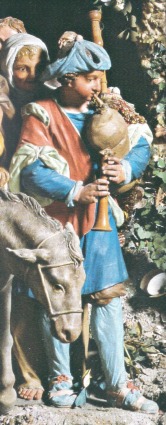
Although they could have dated from earlier, from the late middle ages onwards, there is plenty of surviving iconographical evidence in Portugal to show existence of bagpipes in the country. The evidence is in the form of illuminations, paintings, sculptures and engravings. From the 18th century there are numerous clay and wooden nativity scenes, which include depictions of Portuguese popular and rural life, where one can spot many bagpipers. Whereas in the 19th century, bagpipes tend to appear related to aspects of daily life but particularly in festive scenes and there are also surviving early photographs. There are also abundant in literary references and in researchers’ collections of traditional music in musical scores dating from this period. In addition, there are some early popular sound recordings such as those by Kurt Schlinder in the ‘30s and Armando Leça in the ‘30s/40s, together with some early cinema scenes which portray Portuguese rural life or student festivities from the University of Coimbra, where bagpipers can be found among other musicians and popular singers.

The academic and scientific ethnography, through the medium of sound, grew dramatically during the ‘60s, due to researchers such as Ernersto Veiga de Oliveira, Michael Giacometti and Antonio Mourinho, amongst others, who had observed a disappearance of some practices; but fortunately it was still possible for them to collect music, images and musical instruments so that they could be catalogued, exhibited and published. This body of work has been crucial for the preservation and recovery of such musical practices. It’s also important to mention that a great number of those rural musicians recorded in the ‘60s kept on playing for many years. Bagpipes have since then been studied and collected across the whole north and parts of the centre of Portugal: Viana do Castelo, Braga, Vila Real, Bragança, Porto, Aveiro, Viseu, Coimbra, Leiria, Santarém, Lisboa and North of Setúbal. (see map)
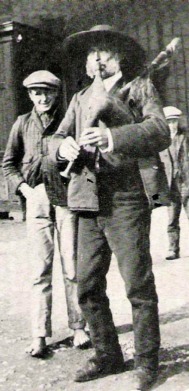
The common names in Portugal for bagpipes are: *gaita, gaita-de-foles, gaita de fole, gaita mirandesa, gaita galega or gaita transmontana. *
Making Gaitas
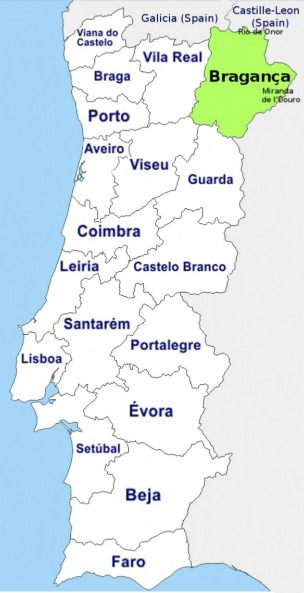
The two of us first met when in 1996 Paulo Tato Marinho (b.1964 Lisbon) started to teach Gaita to Victor Félix (b.1952 Baixa da Banheira, Setúbal). Victor was experienced as a musician and stringed instrument builder. Paulo, besides his activity as a musician and teacher, also made reeds for his own instruments and so they started to collaborate, with the aim of making gaitas. One of their goals was to make an instrument inspired by the ones traditionally used in the Bragança area in Trás-os-Montes, north east of Portugal. These are clearly different from the ones used other parts of the country: morphology, tuning and timbre, which resembles the gaitas from the Spanish border regions of Sanabria and Zamora (gaitas sanabresa, alistana), in the region of Castille-Leon.
At the time the craft of bagpipe building was scarce. There were some makers, but they would only either make them for themselves or would make very small quantities. Ângelo Arribas (b.1936 Miranda de l’Douro) was perhaps the only maker to build for commercial purposes. Due to the lack of makers in the area, it was common practice to use bagpipes acquired in Galicia (north west of Spain), known as “gaita galegas” (Galician bagpipes) which is the term used to describe a type of instrument used, obviously in Galicia but also in other parts of Portugal and Spain.
Paulo had one bagpipe and three chanters from the north east, plus some old reeds, albeit he would make his own. He tried many variations: staples, thicknesses, length, width, with or without skin, etc, and, inspired by these samples, we started to build.
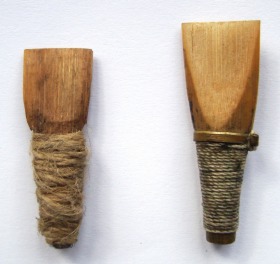
The idea was not to make replicas of the gaitas they had, which would be a difficult task since they differed considerably among them in certain features but instead to aim at a standardized model that would enable not only its tuition but also group playing. We measured and scanned them with medical imaging.
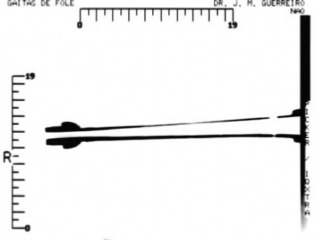
We visited the area of Miranda de l’Douro where we acquired more copies and got in touch with Ângelo Arriba who very kindly showed us his work, which we documented. We then paid a visit to many makers in Galicia, their know-how was key since Victor had a great experience as a luthier, but had never built wind instruments before. They were Antón Corral, Afonso Castro, our fondly remembered Antón Varela, Xosé Gil, Miguel Mosquera and Oli Xiráldez Río. We also spoke to the musician and researcher Alberto Jambrina, from Zamora (Castille-Leon) whose expertise in music and instruments from his region and the neighbouring Portugal was invaluable.
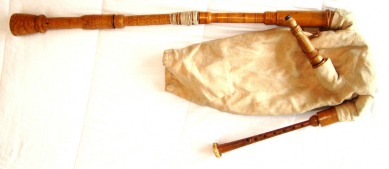
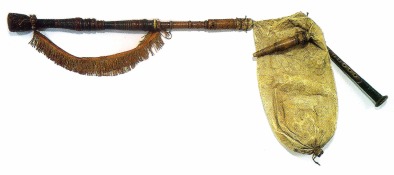
In Lisbon we visited the National Museum of Ethnology and their collection of Portuguese popular musical instruments collected in the 1960s by the ethnologists Ernesto Veiga de Oliveira and Benjamim Pereira which were catalogued with the help of the musician and composer Fernando Lopes Graça. In 1966 these researchers published a book called “Instrumentos musicais populares portugueses – Portuguese popular musical instruments”, which is an important reference for the work in the field. In the museum we were authorized to measure and photograph three gaitas previously owned by bagpipers of this region (Travanca, Ifanes and Rio de Onor – the latter build in Pedrazales, Sanabria, Castille-Leon). We also managed to try out the reeds made by Paulo and check that it worked well.
From 1998 onwards, we started to go to the Saint Chartier Festival in France, where we took full advantage of meeting other makers. Out of those we would like to point out Julian Goodacre from United Kingdom and Paul Beekhuizen from The Netherlands for their kindness and help in running through with us the many aspects of bagpipe and reed building. It was very useful.

The Craft: We acquired tools: the drills, the lathe, the reamer (ordered with the exact measurements needed) and we bought wood, all of this with the financial support of APEGF Associação Portuguesa para o Estudo e Divulgação da Gaita de Foles –The Portuguese Bagpipe Society. Victor was in charge of the actual building craft. Paulo made the reeds, tuned the chanters, assembled the instruments as well as some simple lathe work. Even though, as previously mentioned, the goal wasn’t to replicate the old models, we wanted to address certain features which we considered key.
Bags and Morphology: The use of full skin bags of a young goat or sheep determined, to an extent, the placement of the stocks: chanter in the neck hole, the bass drone in one front leg hole and the blowpipe in the other. We also faced the difficult task of sourcing this type of bag. We wanted to tan the skin ourselves, but it was hard to find a full animal skin in the shape we needed since no one would kill animals in such a way that would allow for this specific bagpipe application. Nevertheless we managed to acquire two skin bags in Asturias - but they weren’t enough. The solution was to use bags from Mezweds which we bought in Tunisia. They were sold at an affordable price with all the features we needed and were of very good quality.

Bag covers: Traditionally not all bagpipers used covers for their bags, although for practical reasons we decided to use them, and tried to draw similarities with certain traditional patterns.
Wood: We started to work with types of wood that were mostly used in the Bragança area such as Common Ash (Fraxinus angustifolia Vahl), Montpellier maple (Acer monspessulanum) locally called Enguelgue and in lesser quantity, Boxwood (Buxus sempervirens).
Timbre: Timbre is determined by many aspects: wood, length, the bore, the thickness, size and position of the holes and the correlation between all these features and the reed. Aside from our experimental reeds, we had as references a number of sound recordings from the ‘60s, ‘70s and ‘80s to which we paid special attention and we think we managed to reach a similar timbre to the traditional gaitas.

Repertoire: Paulo had also been studying repertoire from the area which, to a certain extent, doesn’t differ too much from the rest of the north west of the Iberian Peninsula. It is worth mentioning that in the Praino Mirandés (the upland of Miranda de l’Douro) the dança dos pauliteiros, a stick dance, requires a specific repertoire, choreography and lyrics, called Lhaços meaning “ties” in Mirandese, the local language.
Tuning: We chose to use Bb (A440). In a great number of sound recordings we heard that the gaitas were tuned to Bb, namely those of virtuous Alexandre Feio (Miranda de l’Douro 1914-1999) and Juan Prieto Ximeno (Rio de Onor/Rihonor de Castilla, Bragança and Sanabria 1927-1987). According to our previous research of the chanters and also listening to live and recorded bagpipers, the range of scales used is wide. This is also a conclusion of Theodor H. Podnos research found in the book “Bagpipes and tunings”, Chart II. VIII. Portugal and Spain. Detroit 1974. We decided to use the Bb minor scale using open fingering, with Just Temperament and with the lowest note sounding A. In our opinion it sounds the same and and suits the diversified repertoire of the Bragança area and neighbouring Zamora.
The first gaitas we produced were mainly used by Gaitafolia, the bagpipe group from the APEGF, The Portuguese Bagpipe Society. In 2001, we started to collaborate with Mario Estanislau (b.1975 Maceira,Torres Vedras), a musician, maker of stringed instruments, who had knowledge and practical experience in metal work. In 2003 Paulo stopped making with Viktor and Mario. However, from the late 1990s through to today we have seen the emergence of a number of new makers of similar bagpipes, such as Célio Pires, José Preto, Gonçalo Cruz, Jorge Lira and Pablo Carpintero from Galicia. In reed making, we must mention Henrique Fernandes. By 2007 the process of the Padronização da Gaita de Foles Mirandesa (Normalization and recovery of gaita de foles mirandesa) by several musicians, makers and researchers was concluded. The main goal was to standardise the bagpipe called “Gaita Mirandesa”. The name given, “Gaita Transmontana”, was not a unanimous choice of the musicians and makers, since Trás-os-Montes is too broad a region with plenty of different bagpipes. However, in the aforementioned work of Ernesto Veiga de Oliveira he adopted that name for the bagpipes he heard in Bragança district as a way to distinguish it from others in different parts of the country.
Nowadays this bagpipe is used across the whole country by teachers, students and by amateur and professional musicians in audio and video recordings and live performance. In the last few years Victor Felix and Mário Estanislau have continued to develop and make improvements and have now managed to achieve a chromatic model through the use of cross fingerings. The gaita is supplied with synthetic bags, but is still possible to order leather bag. The Trino, an electronic bagpipe created in Portugal some years ago by Jorge Santos and Hernani Bastos, emulates, amongst others bagpipes, the sound, the tuning and fingering of the Gaita Transmontana.

http://ua-geracon-de-gueiteiros.blogspot.com/ biography of bagpipers
https://www.gaitadefoles.net/gaitadefoles/transmontana1.htm site of Portuguese bagpipe society
http://www.gaitasanabresa.com/inicio.html gaitas from the neighbouring Spanish zone
http://bit.ly/Chanter65 videos of bagpipers in Portugal (Editor’s note: worth a look, there are some great videos here!)
www.paulotatomarinho.pt Paulo’s site – sound tracks will be available soon with nos 3,7 and 14 on gaita Transmontana
- Data Processing Notice (GDPR)
-
@BagpipeSociety on X (formally known as Twitter)
-
TheBagpipeSociety on Instagram
-
 BagpipeSociety on Facebook
BagpipeSociety on Facebook
Something wrong or missing from this page? Let us know!
